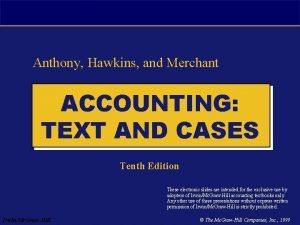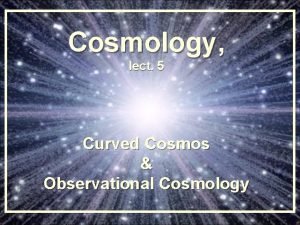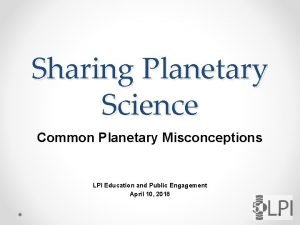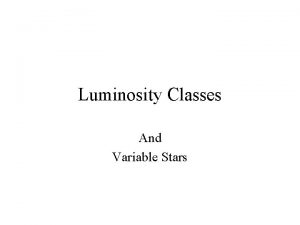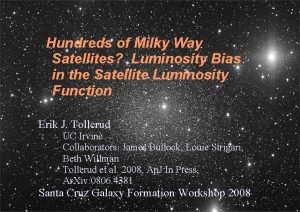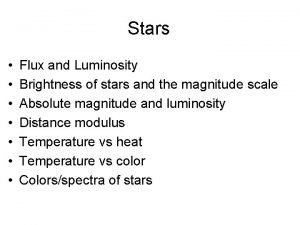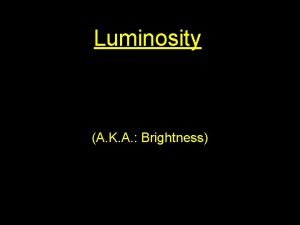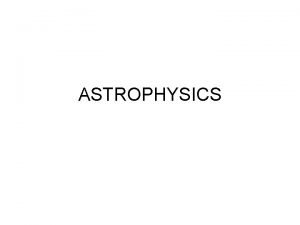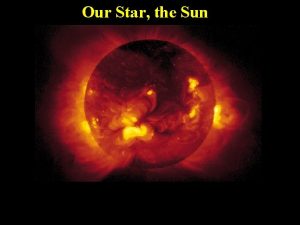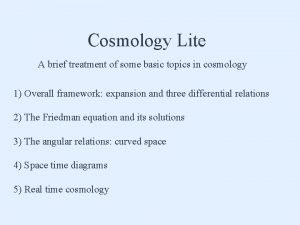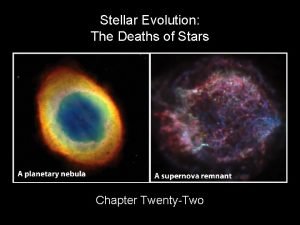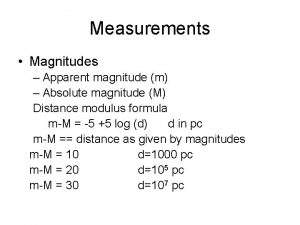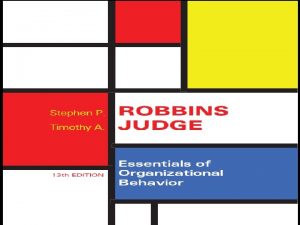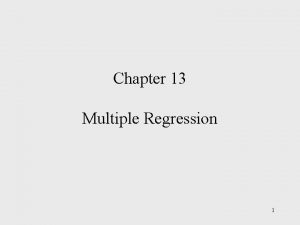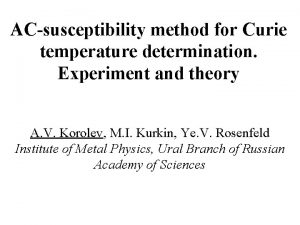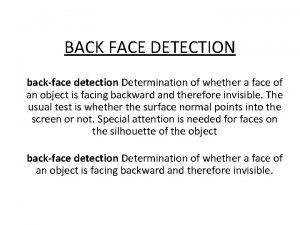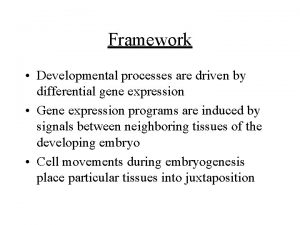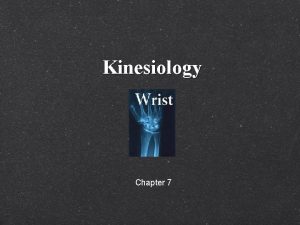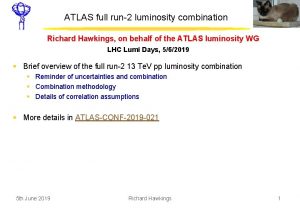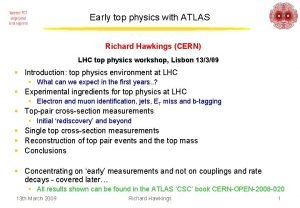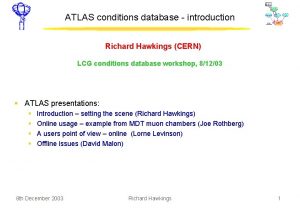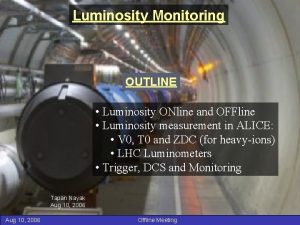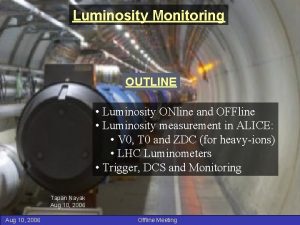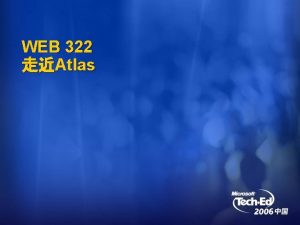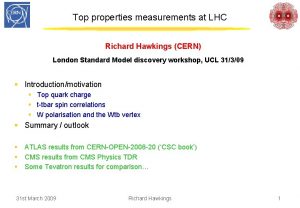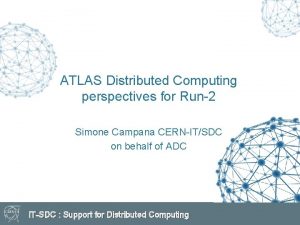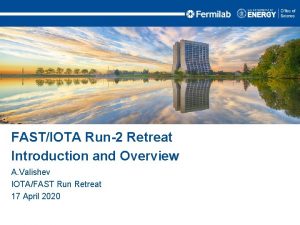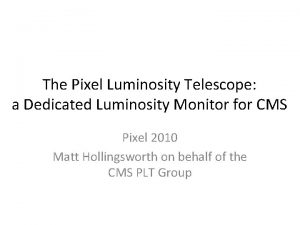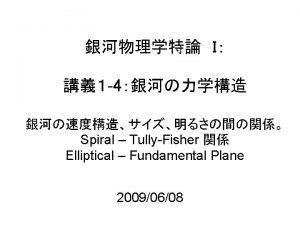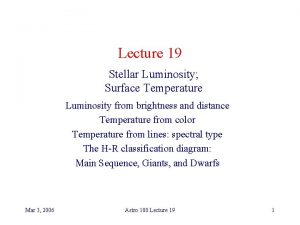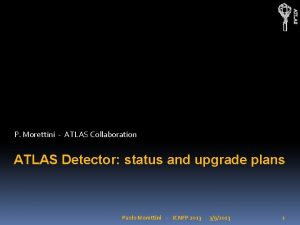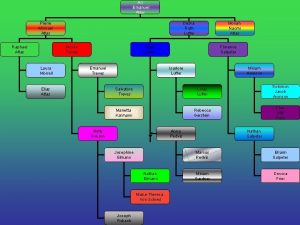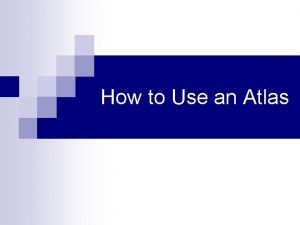Overview of ATLAS Run2 luminosity determination Richard Hawkings























- Slides: 23

Overview of ATLAS Run-2 luminosity determination Richard Hawkings, on behalf of the ATLAS luminosity WG LHC Lumi Days, 4/6/2019 § Overview of the ATLAS luminosity calibration and uncertainties § § § § Luminosity-sensitive detectors in ATLAS The run-2 dataset Brief reminder of vd. M formalism, and dedicated LHC setup vd. M scan analysis and uncertainties Calibration transfer to physics regime (high-µ, bunch trains) (Long-term stability throughout the year – see talk of V. Lang) Final uncertainties and how we might improve § More details in ATLAS-CONF-2019 -021 and luminosity public web pages § Further details in dedicated talks at this workshop from M. Dyndal, W. Kozanecki and V. Lang (and RH again) 4 th June 2019 Richard Hawkings 1

ATLAS luminosity detectors: LUCID & BCM § Primary Run 2 bunch-by-bunch (b-b-b) measurement from LUCID § Cherenkov light from quartz windows of 2 x 16 PMTs at z=± 17 m from IP § b-b-b measurements for every bunch crossing, integrated over ‘luminosity blocks’ of typically 60 seconds § PMT windows coated with Bismuth calibration source § Gain adjusted run-by-run § Several ‘algorithms’ to combine PMTs to ATLAS IP, 17 m § ‘Hit. OR’ combination of 2 x 4 PMTs § Many channels had problems in 2018 § … used single best PMT (C 12) offline instead of OR of surviving 7 § Secondary b-b-b measurements from Beam Conditions Monitor (BCM) § 4 diamond sensors in inner detector volume (z=± 1. 8 m) each side of IP § Do not work well with 25 ns bunch trains – in Run 2 mainly used in vd. M scans 4 th June 2019 Richard Hawkings 2

Other luminosity measurements § Track-counting § Reconstruct tracks in SCT+pixels in randomly-sampled filled bunch-crossings § Data read-out in dedicated event-building stream and reconstructed offline § Readout rate 200 Hz in physics running, >10 k. Hz in vd. M and other dedicated runs § Number of tracks/crossing proportional to <µ>, intrinsically very linear § Several track-selection ‘working points’ used with different sensitivities to pileup § Can resolve individual bunches, but statistically limited Tile calorimeter § Calorimeter algorithms (similar to run-1) § LAr calorimeter high-voltage gap currents (EMEC and FCal) § Tile calorimeter scintillator PMT currents § D 5 and D 6 cells for long-term monitoring § E 1 -E 4 ‘gap’ scintillators sensitive at very low luminosity § Calorimeter measurements are ‘slow’, cannot resolve individual bunch-crossings 4 th June 2019 to ATLAS IP Richard Hawkings 3

ATLAS luminosity calibration in a nutshell 1. van der Meer scan run (once per year) § Absolute luminosity calibration (of LUCID) in controlled conditions, low-µ isolated bunches § Reference luminosity from beam parameters § Need luminous region �� x, �� y and currents n 1 n 2 2. Calibration transfer (~once per year) § Transfer lumi. scale to physics (high-µ, trains) § LUCID over-estimates by O(10%) at µ=40 reference run § Correct with track-counting – much more linear § Cross-check track-counting with Tile calorimeter scintillators E 1 -E 4 § Ltrk/LLUCID Run-to-run stability throughout the year § Is LUCID stable wrt tracks, EMEC, Tile, FCAL, TPX, Z-counting …? 4 th June 2019 Richard Hawkings 4

Run-2 13 Te. V pp datasets § Total of Lint=~156 fb-1 delivered at Run 2 § 139 fb-1 (89%) recorded by ATLAS with sufficient data quality for physics analysis § <3% of Lint in 2015, then 3 progressively better production years in 2016 -18 § Instantaneous luminosity improvements from reduction in �� * and beam emittance § Resulting in maximum <µ> above 60 in 2017 (during 8 b 4 e running period) § Luminosity levelling used for part of 2017 8 b 4 e dataset 4 th June 2019 Richard Hawkings 5

Absolute luminosity calibration – the vd. M method § Basic outline of (factorisable) vd. M formalism x-pos: b 1 b 2 y-pos: b 1 b 2 Per-bunch Lb from revolution frequency fr, bunch populations n 1 and n 2, beam profiles �� 1, 2(x, y) in transverse plane § Overlap-int. from convolved beam sizes �� x �� y Measured in vd. M scan of one beam vs other R(�� x) Calibration constant �� vis: luminosity Beam positions & lumi in July 17 vd. M scan Beam sep. �� x µvis is visible count rate in at the peak of scan curve § Need b-b-b analysis: LUCID and BCM only 4 th June 2019 Richard Hawkings x-scan y-scan 6

LHC setup for vd. M scans § vd. M scans in dedicated low-luminosity running with special LHC setup § �� *=19. 2 m (c. f. 0. 25 -0. 8 m in physics), larger beam emittances 3 -4 �� m. rad § Resulting in large transverse beam sizes of ~90 �� m, c. f. ~15 µm in physics § Beam profiles are large wrt. primary vertex resolution in ATLAS inner detector § 30 -140 isolated bunches – avoid long-range encounters, better beam quality § Reduced bunch currents of ~0. 8 x 1011 p/bunch, minimise beam-beam effects §. . . All resulting in µ≈0. 5 at peak of scans § Scans of 2 x 20 minutes (x+y), several x+y pairs + off-axis scans in a session 2018 ATLAS/CMS vd. M § vd. M fills lasting up to 24 hours with alternating ATLAS and CMS scans sets 4 th June 2019 Richard Hawkings 7

vd. M scan curve fit § Typical scan curve from 2017 § Fitted with Gaussian*polynomial function after background subtrn § Backgrounds determined from preceding empty bunch crossings and unpaired collisions § Try several fit functions § G*P 4, double-G, super-G § Difference gives systematic § Bunch populations of n 1 and n 2: § Current per bunch from FBCT, normalised to DCCT § Corrections of O(0. 1%) for ghost and satellite charges § Determined from LHC LDM and LHCb beam-gas event rates § Systematics <= 0. 05% 4 th June 2019 Richard Hawkings 8

vd. M analysis details § Various corrections must be taken into account (additional systematics) § Orbit drifts during scans, measured using LHC arc and triplet (DOROS) BPMs § See dedicated discussion in talk of W. Kozanecki § Beam position jitter (beam movement within one scan step) § BPMs constrain possible movement within a scan step, input to simulated vd. M scans § Beam-beam effects (scan curve distortion, dynamic �� ) § § Depends on beam energy, transverse beam size, bunch currents, actual �� * and tune Calculated using MADX simulation, as in Run 1 Significant (positive) corrections of 1. 3 -1. 7% on �� vis Systematics from variation of ± 20% on assumed �� *, ± 0. 01 on tune (0. 2 -0. 3% on �� vis) § Emittance growth (uncertainty carried over from run 1 analysis) § Only if horizontal and vertical emittances grow at different rates (which they do) § Non-factorisation effects: �� x�� y does not fully represent the 2 D overlap integral § Dedicated studies and off-axis scans – see talk of M. Dyndal 4 th June 2019 Richard Hawkings 9

Length scale calibration § Relation between nominal (i. e. requested) and actual beam displacement at IP § Displace both beams in same direction § Reconstruct luminous centroid position using vertices reconstructed in ATLAS inner detector § Perform a mini-scan in beam-2 x-pos around fixed beam-1 x-pos to find peak position § Fit linear relation between bump amplitude and luminous centroid to find calibration 2012 LSC § Typically within ~1 -2% of unity § Repeat for B 1 y, B 2 x, B 2 y § From Nov 2017: use same directions of movement as in vd. M scan, to get same hysteresis effect § Uncertainties of 0. 3 -0. 4%, dominated by orbit drift corrections (see talk of W. Kozanecki) § Additional systematics from ID alignment § Assessed by considering ‘realistic’ misalignment scenarios, giving ~0. 1% uncertainty 4 th June 2019 Richard Hawkings 10

vd. M scan consistency - I § Should get same �� vis for different bunch pairs and scan sets § Spread of values for different bunches within same scan gives bunch-by-bunch consistency uncertainty, after subtracting expected spread from statistical errors § Maximum difference between extreme scans (for any algorithm) gives scan-toscan consistency error which is then symmetrised § Gives 1. 2% in 2017, only half that in other years 4 th June 2019 Richard Hawkings 11

vd. M scan consistency – II § Do not expect same �� vis for all the different LUCID and BCM algorithms § But should get same �� x, y values § Quantify this with specific luminosity Lspec § Compare Lspec for different algorithms by plotting ratios for each bunch-pair § Largest deviation of mean from unity gives ‘reference specific luminosity’ error § Largest (0. 4%) in 2018 § Total uncertainty on �� vis: 1. 1 - 1. 5% § Largest in 2017, due to poor scan-to-scan consistency 4 th June 2019 Richard Hawkings 12

Calibration transfer correction § LUCID over-estimates luminosity at high-�� § By ~10% compared to tracks, EMEC, TILE § LUCID calib. from vd. M needs corrn at high-µ § From linear fit to Ltrack/LLUCID ratio vs. µ in a long high-lumi physics fill, giving p 0 (offset) and p 1 (slope) parameters § Track-counting first normalsed to LUCID in head-on period of vd. M fill § p 0 ≠ 1: bunch train and crossing angle effects § Correction determined ~once per year § p 0 and p 1 can be determined from any long physics fill – monitor stability throughout year § In 2017, two corrections were needed § Origin of the LUCID non-linearity not fully understood § But varies according to the bunch train pattern 4 th June 2019 Richard Hawkings 13

LUCID response in bunch trains § Special LHC fill 6194 in 2017 with 2 x 25 ns and 2 x 8 b 4 e trains in same fill § µ-scan allows track-counting / LUCID ratio to be studied vs. µ in a controlled way § Fit the p 0 and p 1 parameters for each bunch in the train separately -6% @ µ=40 § Slope becomes larger (i. e. p 1 more negative) for bunches deeper into the train § For long 25 ns trains, saturates after ~10 bunches, partial ‘recovery’ in 8 b 4 e gaps § Standard correction procedure uses an average correction applied to all bunches 4 th June 2019 Richard Hawkings 14

Systematics on calibration transfer - I § LUCID µ-correction implicitly assumes track-counting has no µ-dependence going from the vd. M regime (µ=0. 5) up to µ≈50 – need to verify this § Only other detector with sensitivity in both ranges is Tile gap scintillators (E-cells) § Compare Tile/track ratios in vd. M fill and closely-following physics fill § Ratio normalised to 1 in vd. M, deviations in physics fill imply relative non-linearity 2017 data § Complications § Low S/B for Tile in vd. M fill § Delicate pedestal subtraction § Residual activation (�� ~1 day) from any high-lumi running just before vd. M fill can swamp signal 1. 3% syst § E-cells age rapidly at high lumi. § Visible drop in response through physics fill 6024 § Inconsistency between E 3 and E 4 § 1. 3% systematic assigned in 2017 § Assume non-linearity is in tracks 4 th June 2019 Richard Hawkings 15

Systematics on calibration transfer - II § Another example, from 2016 – two vd. M fills each followed by high-lumi § Complications visible: E 4 cells § E-cells ageing also affects Tile/tracks ratio in 1 st vs 2 nd vd. M fills § Imperfect pedestal subtraction in 2 nd vd. M fill (residual activation) § 1. 6% systematic assigned in 2016 § Average of high-lumi/vd. M shifts for the two fill pairs, using both E 4 and E 3 cells § In 2018, LSC+vd. M fills done directly after intensity ramp-up (CMS request) § Strong activation effects in vd. M fill § Instead, had a 140 b ‘vd. M-like’ fill wih µ=0. 5 in ATLAS at start of intensity ramp-up, followed by 600, 1200, 2400 b fills: should allow us to study Tile/Tracks evolution § We are still analysing this data; use 1. 3% from 2017 for preliminary 2018 uncertainty 4 th June 2019 Richard Hawkings 16

Long-term stability throughout the year § Compare per-fill LUCID integrated-lumi with other detectors throughout year § After normalising them all to agree in a reference run (red arrow) § Long-term stability uncertainty from ‘stability band’ enclosing bulk of points § Assigned ± 1. 0%, ± 0. 7%, ± 1. 3% and ± 0. 8% for the four years 2015 -18 § More details in talk of V. Lang – also including Z-counting and emittance scans 4 th June 2019 Richard Hawkings 17

Uncertainties and combination § Per-year uncertainty summary § Treating 2015+16 as one dataset § Absolute vd. M calibration subtotal § +Contributions to to physics lumi. § Total uncertainties for individual years are 2. 0 -2. 4% § Largest single uncertainty from calibration transfer § Combination of years § Taking correlations into account § */+=fully/partially correlated § See talk of R. Hawkings tomorrow § Total run 2 lumi: 139. 0± 2. 4 fb-1 § Uncertainty 1. 7%, dominated by calibration transfer and then longterm stability 4 th June 2019 Richard Hawkings 18

Speculation – where can we improve further? § Leading uncertainty is from calibration transfer, correlated between years § 1. 3 -1. 6%, based on delicate Tile vs tracks comparisons § Inconsistencies in these comparisons assigned as a systematic on track-counting, but possibly telling us more about Tile response ? § More to learn from 2018 post-TS 1 intensity ramp-up, µ-scans in 2017+2018, and ‘internal’ studies of track-counting systematics (e. g. varying track selections) § Can the vd. M calibration uncertainties be improved? § Total uncertainty on vd. M is 1. 1 -1. 5% for individual years, partially correlated § Largest effects coming from non-factorisation, and scan-to-scan & bunch-to-bunch consistency tests § Some element of ‘chance’ – some scan sessions are better than others – why? § We are also evaluating these uncertainties rather conservatively – ‘maximum deviation seen’ makes less sense when you have lots of bunches/ scans / algorithms § Fit model uncertainties are also significant – better choice of fit functions? § 1. 7% now, could we get to 1. 5% for the final run-2 uncertainty? 4 th June 2019 Richard Hawkings 19

Conclusion § Described the luminosity calibration for complete run 2 13 Te. V high-�� dataset § Absolute calibration of LUCID (and BCM) from vd. M scans in each year § Extrapolated to physics regime using complementary measurements from other detectors § Preliminary calibration has uncertainties of 2. 0 -2. 4% per year, and 1. 7% for the combined run 2 dataset § A great success – thanks to everyone involved ! § Largest uncertainty from calibration transfer from vd. M to physics regime § Calibration applicable to full run 2 high-�� dataset (or subsets) § Not applicable to special runs with low pileup recorded for W/Z physics (�� =2) or in high �� * very low-�� running for ALFA § These require special treatment – mainly for calibration transfer to low-µ bunch train running 4 th June 2019 Richard Hawkings 20

Additional slides 4 th June 2019 Richard Hawkings 21

ATLAS luminosity detectors 4 th June 2019 Richard Hawkings 22

LHC parameters in physics running § Values typical of LHC peak performance in the different years § Both 25 ns long-train and 8 b 4 e values given for 2017 running 4 th June 2019 Richard Hawkings 23
 Athony hawkings merchant
Athony hawkings merchant Looking for richard analysis
Looking for richard analysis Luminosity distance
Luminosity distance Mizar luminosity
Mizar luminosity Luminosity lpi
Luminosity lpi Luminosity class definition
Luminosity class definition Luminosity
Luminosity Flux luminosity equation
Flux luminosity equation Luminosity vs brightness
Luminosity vs brightness Which is one physical property that all stars have?
Which is one physical property that all stars have? What is solar luminosity
What is solar luminosity Luminosity distance
Luminosity distance Luminosity
Luminosity Apparent vs absolute magnitude
Apparent vs absolute magnitude Manifestation determination flowchart
Manifestation determination flowchart The investment of an employee's physical cognitive
The investment of an employee's physical cognitive Sex linked punnett squares
Sex linked punnett squares Adjusted multiple coefficient of determination
Adjusted multiple coefficient of determination He approached the task with sheer determination
He approached the task with sheer determination Curie point experiment
Curie point experiment Back face detection
Back face detection Qneu
Qneu Differentiation vs determination
Differentiation vs determination Radius side determination
Radius side determination
